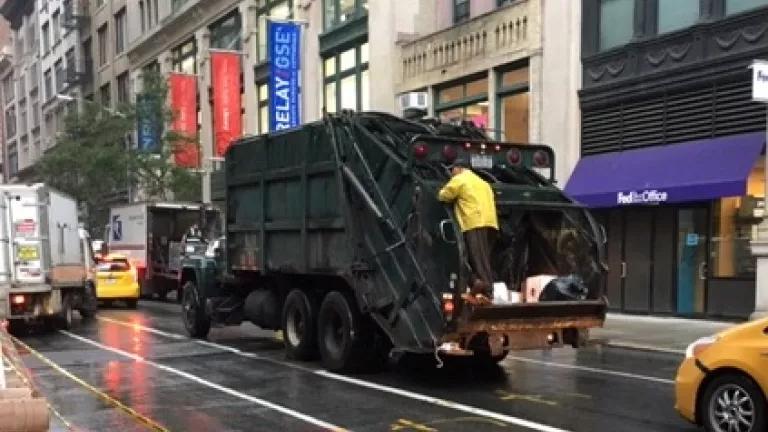
On October 31, 2019, the New York City Council, by a vote of 35 to 13, passed the legislation that is the subject of this blog.
The New York City Council is poised to enact legislation that would dramatically reshape the system for collecting and handling trash from businesses, restaurants and other commercial establishments in the nation’s largest city.
The ambitious bill is intended to address a host of environmental, labor and public safety problems that have plagued the commercial waste handling system in New York for decades.
This legislation is likely to spark the most far-reaching reform of the commercial carting industry here since efforts to root out organized crime in the 1990s. Enacting a waste zone system will be like the Council pulling off a triple play—the legislation will cut truck traffic and pollution, improve pedestrian safety and the quality of life in city neighborhoods, and enhance conditions for private sanitation workers, all in one fell swoop.
If, as expected, the legislation passes, the existing approach for dealing with more than 3 million tons a year of commercial waste—in which trucks from dozens of different carting companies race across the city in an irrational routing scheme to pick up trash from businesses—would be scrapped.
It would be replaced by a system that divides the city into at least 20 separate zones, with the New York Sanitation Department awarding commercial waste collection contracts to no more than three carters per zone. The ten-year contracts would be awarded to carters who met specific criteria aimed at enhancing customer service, sustainability, public safety and working conditions for private sanitation employees.
(Under the new law, the Department would also select up to five carters who could collect citywide from buildings served by containerized waste receptacles.)
Most significantly from an environmental standpoint, the new approach would reduce duplicative routes, slashing commercial waste collection truck traffic in half and eliminating roughly 18 million diesel truck miles every year.
Among the benefits of this reduction in vehicle-miles-traveled:
- Greenhouse gas emissions from the current fleets of diesel-powered garbage trucks would fall between 42% and 67%, depending on the county, the roadway type and travel speeds;
- Particulate matter pollution, which causes localized air quality problems in city neighborhoods, especially communities already overburdened with waste transfer facilities, would also be cut roughly in half; and
- Pedestrian and traffic safety would be enhanced, as the new system’s shorter, more sensible routes would mean that carters would drive shorter distances (and at slower speeds) to complete their nightly routes.
One of the unusual impacts of the waste zone legislation is that it is expected to produce multiple public benefits across a broad range of issues.
For example, the new zoned system would also:
- Incentivize carters to increase their reliance on recycling and composting for ultimate disposal of organics waste; this should decrease global warming methane emissions from disposal of organics in landfills and incinerators;
- Select carters for zone contracts based in part on their commitment to utilize waste transfer stations closes to where trash is collected; this should lessen the burden on environmental justice communities in the South Bronx, North Brooklyn and Southeast Queens, which are already home to more than their fair share of waste disposal facilities;
- Improve working conditions for private sanitation workers, by selecting carters for zone contracts that have demonstrated compliance with worker labor and employment laws, establish worker safety training programs, etc.
The 60-page bill, Intro 1574-A, has been championed by Councilmember Antonio Reynoso, with the support of more than two dozen fellow councilmembers. Speaker Corey Johnson, who has been building an impressive environmental track record during his tenure as Speaker, was one of the earliest supporters of this legislation.

NRDC, which has advocated for this reform legislation for more than five years is a proud member of the Transform Don’t Trash coalition. The TDT coalition introduced the idea of commercial waste zoning in New York and has spearheaded support for enabling legislation ever since. The Coalition members include the New York City Environmental Justice Alliance, ALIGN, New York Lawyers in the Public Interest and the Teamsters Joint Council 16.
This legislation is the product of extensive public involvement. In developing the final plan, the Sanitation Department held an intensive stakeholder process, which included broad participation from industry, civic groups and community organizations. Two separate hearings were held on the draft environmental impact statement for this legislation and the City Council itself held a well-attended public hearing on the legislation, as introduced, earlier this year.
New York City Sanitation Commissioner Kathryn Garcia, a strong supporter of this legislation and an architect of the final proposal, sees the establishment of commercial waste zone proposals as part of the Administration’s sustainability legacy. Assuming favorable City Council action, Mayor De Blasio is expected to sign the bill before year’s end.

